#Excess Energy Discovered in Spark Gap Experiment! ; http://www.zpenergy.com/modules.php?name=News&file=article&sid=1717
Posted on Tuesday, January 31, 2006 @ 17:55:44 PST by vlad
Bill Alek writes: Hello all,
I have some very encouraging information to report in regards to my spark gap experiments: http://www.intalek.com/Index/Projects/SparkGapExp/SparkGapExp.htm
Excess electrical energy has been discovered in spark gaps using Carbon/Graphite – Tungsten rods. Assuming an ideal system, a maximum COP of 171% is possible using a Wimshurst Generator as the primary high-voltage dynamo.
A Tesla-like step-down transformer T1 with a ferrite rod is used to efficiently reduce the high-voltage down to safe practical levels, which can easily be distributed and measured. As shown in Fig. 1, successive electric discharges or Electrum Validum (EVs) discharges are generated, and their associated energy is collected in a 10uf low loss capacitor during a given period of time.
William S. Alek, Exploring Gravitational and Inertial Mass fluctuations, Radiant Energy, and Temporal Anomalies http://groups.yahoo.com/group/intalek
INTALEK, INC. PHONE/FAX: 219.924.2742 EMAIL: wsalek01@intalek.com ; HOME PAGE: http://www.intalek.com/
3506-43rd. Place,Highland, IN 46322 USA
—————-
Hello all,
I added a close-up view of the Carbon/Graphite – Tungsten spark gap shown in Fig. 3:
Secondly, the Wimshurst Generator is powered by hand.
In regards to the COP calculation, I placed a “black box” ONLY around the Carbon/Graphite – Tungsten spark gap, and I’m observing ONLY the energy difference between the spark gap and NO spark gap.
The key here is the Carbon electric discharge.
Bill
# The Motionless Battery Shock Charger, Claiming a COP greater than 4.0 ;, http://www.theverylastpageoftheinternet.com/newclaims/intalek/shock_charger.htm
US03963976 http://www.delphion.com/cgi-bin/viewpat.cmd/US03963976__ – A Pulsed Current Battery Charging Method.
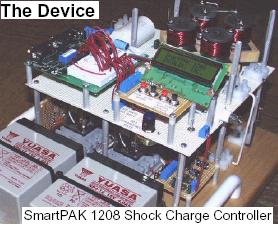
# Spark Gap Experiments, William Alek, UPDATED: February 2, 2006, http://www.intalek.com/Index/Projects/SparkGapExp/SparkGapExp.htm
Excess electrical energy has been discovered in spark gaps using Carbon/Graphite – Tungsten rods. Assuming an ideal system, a maximum COP of 171% is possible using a Wimshurst Generator as the primary high-voltage dynamo. A Tesla-like step-down transformer T1 with a ferrite rod is used to efficiently reduce the high-voltage down to safe practical levels, which can easily be distributed and measured. As shown in Fig. 1, successive electric discharges or Electrum Validum (EVs) discharges are generated, and their associated energy is collected in a 10uf low loss capacitor during a given period of time.
The energy stored in a capacitor is calculated as follows: E = 1/2 C Vsq.
Where, E is the energy stored in the capacitor. C is the capacitance. V is the voltage across the capacitor.
The Wimshurst Generator used in this experiment is capable of generating voltages up to 75,000 volts, and is available from Edmund Scientific http://wwww.shop.com/product/Wimshurst_Electrostatic_Generator/9045791.htm .
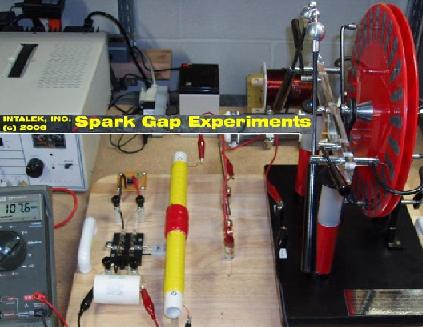
Figure 1. Spark gap experiments using the Wimshurst Generator.
Fig. 2 details the spark gap test platform. Above center-left shows the spark gap where excess electrical energy is observed. This energy is transferred through a Tesla-like step-down transformer T1 where the single layer primary winding of the transformer is shown in yellow and the single layer secondary winding is shown in red. Its imperative to use single layering because it minimizes electric arcing. A ferrite rod is used in this transformer to improve efficiency by increasing its’ overall inductance. A knife switch is used to direct the flow of energy to either a capacitor or a LED display.
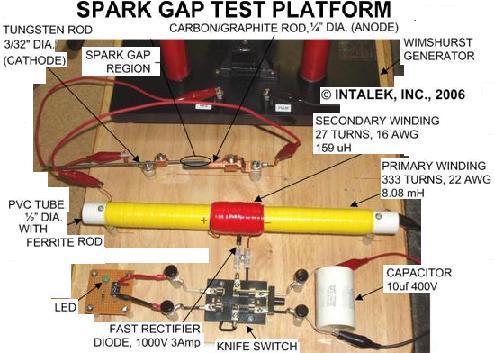
Figure 2. Detail of the test platform.
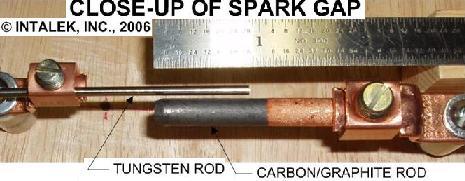
Figure 3. Close-up view of Carbon/Graphite – Tungsten spark gap.
Fig 4. shows the electrical schematic of the test platform. A high electrostatic voltage is generated by counter-rotating disks and the energy that’s collected is stored in Leyden Jars. This stored energy is discharged through a large spark gap with a gap width of approximately 3/4″, as shown. The circuit is completed by connecting the Carbon/Graphite – Tungsten spark gap rods and the Tesla-like transformer T1 to the base of the Leyden Jars.
Fig. 5 details the spark gap test results. The Wimshurst Generator is operated for a time period of 15 seconds. At the end of this period, the voltage across capacitor C1 is logged. The test platform is operated with and without the Carbon/Graphite – Tungsten rod spark gap, and the resulting voltage is logged.
Knowing the energy stored in the capacitor C1 and assuming an ideal system, its possible to calculate the Coefficient of Performance (the COP) as shown below. The maximum COP is 171% as shown in Fig. 6.
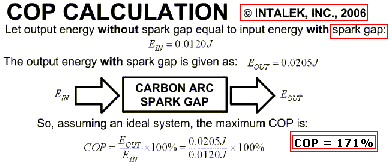
Figure 6. The COP calculation.
My conclusion is the Carbon arc is performing as a NEGATIVE resistance-like device. The bottom line is that there is MORE energy charging up the capacitor C1 with the spark gap than without the spark gap. Therefore, the Carbon arc looks very promising as providing excess energy, once properly harnessed.
## MOTIONLESS BATTERY SHOCK CHARGER (c) INTALEK, INC., October, 2001 ; From PDF CHARGER_Alek ( 350 Ko):
THE DEVICE THAT EXTRACTS EXCESS ENERGY FROM THE ACTIVE VACUUM (ZPE, OR AETHER)
# Basic Shock Charger Model
When Switch S1 Is Closed, The Current (iBAT1) Flows From The Source Battery (BAT1) And Energizes Coil L1. This Action Transfers Or Discharges Energy From The Source Battery (BAT1) And Stores It In L1.
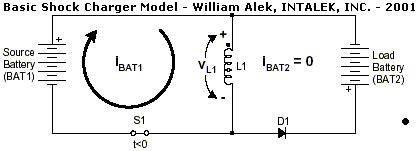
When Switch S1 Opens, The Voltage (vL1) Across The Coil L1 Reverses (Lenz’s Law) And The Energy Stored In L1 Flows Out As A High-Current Pulse (iBAT2). This Action Very Efficiently Transfers Energy From L1 To The Load Battery (BAT2).

# The Coil/Magnet/Coil Assembly
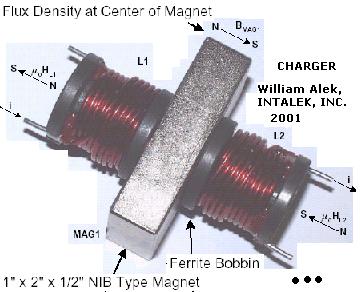
L1 or L2: Coilcraft, Part No.: PCV2-274-10, RDC = 0.06 Ohm, L = 282 microH
# Mechanism For Extracting Excess Energy From The Active Vacuum
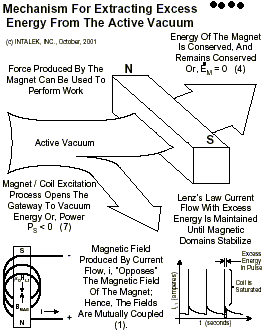
# The Results
1.Without the magnets, I observed approximately 80% of rated energy capacity transferred from BAT1 to BAT2.
2.When I placed magnets on the ferrite bobbins of each coil set, I observed approximately 95% of rated energy capacity transferred from BAT1 to BAT2. This indicates an “increase” in energy of 15%!
# What’s Next?
Continue research and development effort by working towards unity gain (COP = 1, i.e. “Self-Runner”), and ultimately overunity (COP > 1, i.e. “1 Watt Challenge”).
a.Improve coil switching design.
b.Test core material.
c.Test magnets.
# References
1.Leon Dragone, “Energetics of Ferromagnetism”, 1989.
2.Howard Johnson, “Permanent Magnet Motor”, US Patent 4,151,432, April 24, 1979.
3.Hayt & Kemmerly, “Engineering Circuit Analysis”, McGraw Hill, 1993.
4.McLyman, “Transformer and Inductor Design Handbook”, Marcel Dekker, 1988.
5.William H. Clark, “Pulsed Current Battery Charging Method and Apparatus”, US Patent 3,963,976, June 15, 1976.
6.Technical Marketing Staff of Gates Energy Products, Inc., “Rechargeable Batteries, Applications Handbook”, Butterworth-Heinemann, 1992.
## HOW TO BUILD FREE ENERGY AND ANTIGRAVITATIONAL DEVICES AND SYSTEMS THAT UTILIZE GRAVITATIONAL MASS FLUCTUATIONS ; From PDF gmf_Alek_ZPE (1,716 Mo, 104 pages)
William S. Alek, INTALEK, INC., 3506 43rd Place,, Highland, IN 46322-3129, USA, Phone:(219) 924-2742, http://www.intalek.com/, wsalek01@intalek.com.
– ABSTRACT:
The purpose of this paper is to reveal a portion of classical physics that contains an intrinsic relativistic phenomenon called Gravitational Mass Fluctuations. A correlation has been established between mass, inductors, and capacitors, thereby linking gravity to electromagnetism. A simplified gravitational mass relativity model called Natural Relativity (NR) Theory is presented and shown to be a primary gravitational effect. This theory is correlated to Einstein’s Special Relativity (SR) Theory, and as a consequence, creates a new Principle of Equivalence Theorem and a secondary gravitational effect. A temporal rotation operator is introduced using Eulers Identity, which shows the complex (i.e., time-future) motion of matter. The speed of light c, Planck’s constant h, permeability Uo, permittivity Eo, Boltzmann’s Constant k, electric charge q, and the Fine Structure Constant á are invariant between equipotential surfaces of gravity because the fluctuation or curvature of the parameters that compose these constants are shown to evaluate to unity gain. In other words, these constants remain constant anywhere with a given gravity well.
Gravitomagnetic Theory shows that the magnetic field energy produced by a moving electron is equivalent to its special relativistic mass fluctuation, and therefore, is shown to couple to gravity. This motion can either have a typical velocity or a complex (i.e., time-future) velocity. If the velocity is complex, then the special relativistic mass fluctuation of an electron is NEGATIVE, exhibit an antigravitational effect, and produce a complex (i.e., time-future) magnetic field. In addition, the total field energy of a complex magnetic field contained within a volume is NEGATIVE. In the Bohr model of the Hydrogen atom, an Amperian Current is described as an electron circulating around a nucleus at a relativistic speed. This creates a magnetic induction emerging from the center of the nucleus. Canceling this field by applying an external magnetic induction causes the velocity of the electron to become complex. The presence of NEGATIVE RESISTANCE, the production of NEGATIVE ENERGY, and the control of GRAVITY/ANTIGRAVITY occur by fluctuating the mass of an object. The theory presents a conceptual breakthrough in energy and high-speed field propulsion technology, and explores solutions based entirely within the framework of classical physics.
– INTRODUCTION
Puthoff (1996) coined the phrase, metric engineering, and Puthoff, Little and Ibison (2002) consider the vacuum to be a polarizable medium, and that it can be expressed in terms of tensor formulations of curved space-time. The bending of light passing near a massive object is caused by induced spatial variation in the refractive index of the vacuum near the object.
This is correlated to changes in permeability Uo and permittivity Eo of the vacuum. Changes occurring in the vacuum also affect the mass of objects, the length and bending of rulers, the frequency of clocks, the energy of light, etc.
This paper links gravity with electromagnetism by presenting formulations of curved spacetime in terms of classical physics, which are caused by relativistic fluctuations of mass M , inductance L, and capacitance C of an object.
For example, when an object with mass M naturally falls downward in a given gravity well, its natural relativistic mass Mincreases due to Newtonian Gravitation, or universal mass attraction.
Therefore, the new mass of an object is displaced to a new position within this well, and mass-energy remains conserved. However, by converting this increase in relativistic mass Mto energy, a force acts upon the object, and the new mass is now displaced to its original position that was higher vertically in the well. The object exhibits an antigravitational effect. The rate of change of this fluctuation could cause the speed of the object to easily exceed the speed of light. This is because the relativistic gravitational mass of the object, which is shown to be convergent, is moving at right angles to a relativistic inertial mass, which is shown to be divergent. Since the speed of the object with relativistic gravitational mass has no known upper limit, the resulting speed through deep space could be enormous and necessitates the use of the warp factor equation.
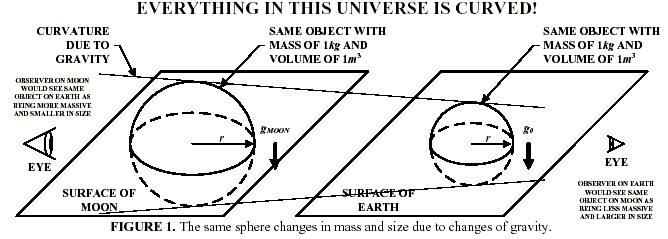
– THE MUTUAL EXCLUSION PRINCIPLE:
– GRAVITATIONAL INDUCTIVE MASS FLUCTUATION:
– GRAVITATIONAL CAPACITIVE MASS FLUCTUATION:
– THE GRAVITATIONAL COUPLING OF A FLUCTUATING MASS, INDUCTOR OR CAPACITOR:
– NATURAL RELATIVITY THEORY:
– SPECIAL RELATIVITY THEORY:
– A NEW PRINCIPLE OF EQUIVALENCE THEOREM:
– HOW GRAVITY AFFECTS THE VOLUME OF OBJECTS:
– HOW VELOCITY AFFECTS THE VOLUME OF OBJECTS:
– HOW GRAVITY AFFECTS THE FREQUENCY OF TIME:
– HOW VELOCITY AFFECTS THE FREQUENCY OF TIME:
– HOW GRAVITY AFFECTS AN INTERVAL OF TIME:
– HOW VELOCITY AFFECTS AN INTERVAL OF TIME:
– HOW GRAVITY AFFECTS LINEAR MOMENTUM:
– HOW VELOCITY AFFECTS LINEAR MOMENTUM:
– HOW GRAVITY AFFECTS ANGULAR MOMENTUM:
– HOW VELOCITY AFFECTS ANGULAR MOMENTUM:
– THE SPACE-TIME MEDIA OR THE AETHER:
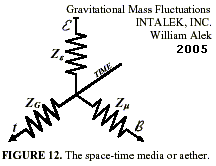
– THE GRAVITATIONAL COUPLING OF AN ELECTROMAGNETIC WAVE:
– HOW GRAVITY AFFECTS THE PERMEABLILITY OF SPACE-TIME MEDIA:
– HOW GRAVITY AFFECTS THE PERMITTIVITY OF SPACE-TIME MEDIA:
– HOW GRAVITY AFFECTS THE VIRTUAL RESISTANCE OF SPACE-TIME MEDIA:
– HOW GRAVITY AFFECTS THE SPEED OF LIGHT:
– HOW GRAVITY AFFECTS BOLTZMANN’S CONSTANT:
– HOW GRAVITY AFFECTS AN ELECTRIC CHARGE:
– HOW GRAVITY AFFECTS THE FINE STRUCTURE CONSTANT:
– A TYPICAL ELECTROMAGNETIC WAVE:
– GRAVITATIONAL BLUE SHIFTING OF AN ELECTROMAGNETIC WAVE:
– GRAVITATIONAL RED SHIFTING OF AN ELECTROMAGNETIC WAVE:
– GRAVITOMAGNETIC THEORY:
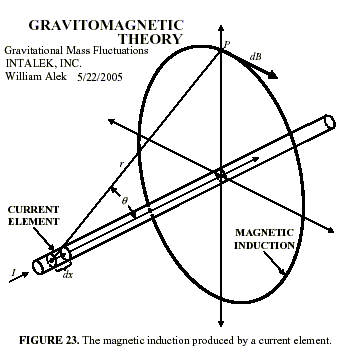
– COMPLEX AMPERIAN CURRENTS:
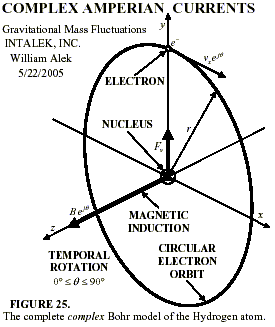
– COMPLEX ELECTRON DRIFT VELOCITY:
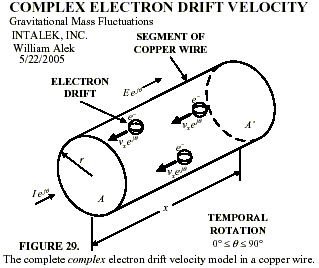
– COMPLEX RESISTOR:
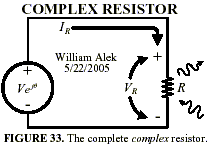
– COMPLEX INDUCTOR:
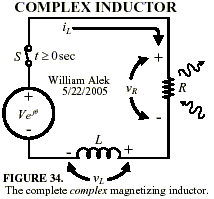
– COMPLEX CAPACITOR:
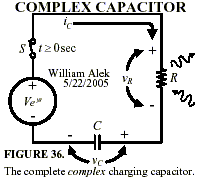
– TESLAS COMPLEX FIELD GENERATOR:
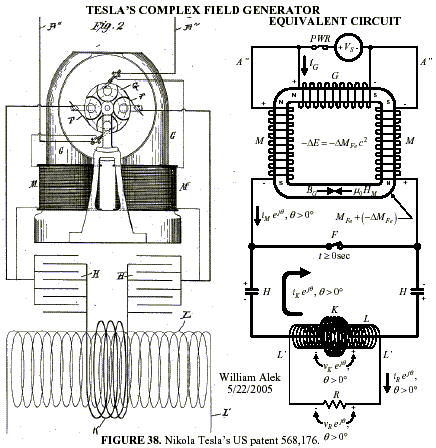
– MASS FLUCTUATION TECHNOLOGIES:
Since a theoretical link was established between gravity and electromagnetism, two mass fluctuation technologies are presently under investigation. Both technologies are electrical devices with the first being inductive-based, and the second being capacitive-based. Shown below is a simplified schematic diagram that highlights their operation.
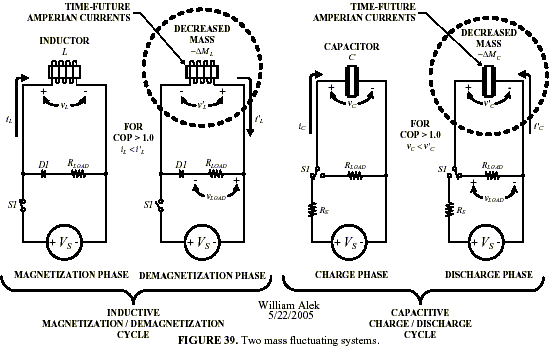
These systems are cyclic, and alter the local gravity well. The mass of these systems is converted to excess field energy during the magnetizing/charging phase. During the demagnetizing/discharging phase, excess electrical energy is collected, and mass is restored after this phase. Then, the cycle begins again. As a consequence, clocks runs faster due to broken symmetry of mass-energy conservation in the proximity of these devices because mass is converted to time-future energy.
– A CONCEPT VEHICLE THAT UTILIZES GRAVITATIONAL MASS FLUCTUATIONS:

Shown above is a concept vehicle for tunneling through vast distances of space. The first step concerning this antigravitational system is the controlled fissioning or disassociation of tungsten metal. This metal is used as a fuel source of gravitational energy bound as mass within the element. As the matter of the metal disassociates, it radiates away this gravitational energy in the form of a temporal field within the vehicle. This causes clocks to speedup and the mass of the vehicle to decrease. The second step begins by switching off the fissioning process, thereby turning off the temporal field. Mass converted to electrical energy is amplified as field energy in the outer hull, which can be stored, radiated away, or used to power the vehicle. The vehicle seeks a new equipotential surface of gravity that corresponds to its new mass, thus producing lift. Then, the cycle begins again.
– ENERGIZING THE GRAVITATIONAL PROPULSION UNIT (GPU):
– CLOSED-LOOP GRAVITATIONAL FLIGHT CONTROL SYSTEM:
– CONCLUSION:
The parameters of space and time identified as mass, volume, frequency, time, temperature, and energy are functions of gravity. Therefore, controlling the mass of a space vehicle, for example, controls gravity, but more precisely, controls its current position within a given gravity well. The control of how fast mass fluctuates controls the speed of the vehicle through this well. Whether the vehicle implementing GMF is above the surface of the Earth or traveling at warp factor 1.53 through deep space, the physical constants where shown in previous sections to remain invariant within the vehicle.
The vehicles Gravitational Propulsion Unit, or GPU, using one of the two devices that are under investigation control mass by an electrical means, thus utilizing the theoretical link between gravity and electromagnetism presented in this paper. Either device can change its own mass by converting it to excess electrical energy, and as a consequence, the broken symmetry of mass-energy conservation causes the gravitational energy equivalent of mass to be radiated away as a temporal field. A force is created and acts antigravitationally on the device. This changes the frequency of clocks within the vehicle relative to clocks outside of the vehicle.
The vehicle will require a Gravitational Flight Control System, or GFCS, capable of controlling the GPU. This control system acts as an interface between man and the GPU. The development of this system can be directly implemented from the mathematical formulations in this paper. An additionalequirement is the development of real-time navigation software programs that maps the gravity of the entire Sol System, and includes the nearby stars.
– REFERENCES:
– Hal Puthoff, SETI, the Velocity-of-Light Limitation, and the Alcubierre Warp Drive: An Integrating View, Physics Essays, Vol. 9, No. 1, pp. 156-158, 1996.
On the Web, download at: http://www.intalek.com/Index/Projects/Research/seti.pdf
– Hal Puthoff, S. Little, and M. Ibison, Engineering the Zero-Point Field and Polarizable Vacuum for Interstellar Flight, JBIS, Vol. 55 pp 137-144, 2002.
On the web, download at: http://www.intalek.com/Index/Projects/Research/jbis_final.pdf
– Paul Marmet, Natural Length Contraction Due to Gravity, 2001.
On the Web at: http://www.intalek.com/Index/Projects/Research/NaturalLengthContractionDueToGravity.htm
– Paul Marmet, Fundamental Nature of Relativistic Mass and Magnetic Fields, 2003.
On the web at: http://www.intalek.com/Index/Projects/Research/FundamentalNatureOfRelativisticMassAndMagneticField.htm
– Paul Marmet, Natural Length Contraction Due to Kinetic Energy. Journal of New Energy 2001.
On the Web at: http://www.intalek.com/Index/Projects/Research/NaturalLengthContractionMechanismDueToKineticEnergy.htm
– R.V. Pound and G.A. Rebka Apparent Weight of Photons, Phys. Rev. Letters. 4,337 1964.
On the web at: http://www.intalek.com/Index/Projects/Research/PoundRebka.htm
– Carlos Calvet, Gravitation and Inertia as a Consequence of Quantum Vacuum Energy, Journal of Theoretics Vol.4-2.
On the web, download at: http://www.intalek.com/Index/Projects/Research/UGC-QE-final.pdf
– Jean-Louis Naudin, The Parametric Power Conversion, 1997.
On the web, download at: http://www.intalek.com/Index/Projects/Research/ppc.PDF
– Nickolay Zaev, Inductive Conversion of Heat Environmental Energy to Electrical Energy, New Energy Technologies, Issue #1 Jan-Feb 2002, pp. 40-44.
On the web, download at: http://www.intalek.com/Index/Projects/Research/zaev1.pdf
– Nickolay Zaev, Fuel-Less Energetics, New Energy Technologies, Issue #2 Mar-Apr 2002.
On the web, download at: http://www.intalek.com/Index/Projects/Research/zaev2.pdf
– Nickolay Zaev, Ferrites and Ferromagnetics Free Energy Generation, New Energy Technologies, Issue #5 Sep- Oct 2002.
On the web, download at: http://www.intalek.com/Index/Projects/Research/zaev3.pdf
– James F. Woodward, Transient Mass Fluctuation, 1998.
On the web at: http://www.intalek.com/Index/Projects/Research/TRANSIENT%20MASS%20FLUCTUATIONS.htm
– James F. Woodward, Radiation Reaction, 1998.
On the web at: http://www.intalek.com/Index/Projects/Research/RADIATION_REACTION.htm
– Robert Neil Boyd, Alterations of Aether Density.
On the web at: http://www.rialian.com/rnboyd/aether.htm
– Bruce DePalma, On the Nature of Electrical Induction, 1993.
On the web at: http://www.intalek.com/Index/Projects/Research/OnTheNatureOfElectricalInduction.htm
– Leon Dragone, Energetics of Ferromagnetism, 1989.
On the web, download at: http://www.intalek.com/Index/Projects/Research/Dragone.pdf
– William Alek, Analysis of Leon Dragone’s, Energetics of Ferromagnetism, 2003.
On the web, download at: http://www.intalek.com/Index/Projects/Research/DragoneAnalysis.pdf
– Stanley Byers, Radiant Pressure of Remote Forces, 1995.
On the web, download at: http://www.intalek.com/Index/Projects/Research/RadiantPressure.pdf
– Tom Van Flandern, The Speed of Gravity – What the Experiments Say, 1998, corrections 2002.
On the web at: http://www.intalek.com/Index/Projects/Research/TheSpeedofGravity-WhattheExperimentsSay.htm
– Tom Bearden, Scalar Waves, NEW ENERGY NEWS, July 1998.
On the web at: http://www.intalek.com/Index/Projects/Research/SCALAR_WAVES.htm
– Nikola Tesla, Apparatus for Producing Electric Currents of High Frequency and Potential, US Patent 568,176, issued September 22, 1896.
On the web, download at: http://www.intalek.com/Index/Projects/Patents/00568176.pdf
– Neil Ashby, Relativistic Effects on Satellite Clocks, 2003.
On the web, download at: http://www.intalek.com/Index/Projects/Research/RelativisticEffectsOnSatelliteClocks.pdf
– Robert A. Nelson, Practical Relativistic Timing Effects in GPS and Galileo, 2003.
On the web, download at: http://www.intalek.com/Index/Projects/Research/gps.ppt
– Hayt & Kemmerly, Engineering Circuit Analysis, 5th edition, McGraw Hill, 1993, ISBN 0-07-027410-X.
– Col. William McLyman, Transformer and Inductor Design Handbook, 2nd edition, Marcel Dekker, 1988, ISBN 0-8247-7828-6.
– Weidner and Sells, Elementary Classical Physics, Volume One, 2nd edition, 1974.
– Shadowitz, The Electromagnetic Field, 1999, ISBN 0-486-65660-8.
– Vincent Del Toro, Electromechanical Devices for Energy Conversion and Control Systems, Prentice-Hall 1968.
– Halliday and Resnick, Physics, Part II, Wiley 1962, ISBN 0-471-34523-7.
– Francois Cardarelli, Scientific Unit Conversion, 2nd edition, Springer, 1999, ISBN 1-85233-043-0.
– Stephen Whitfield, The Making of Star Trek, 1968, ISBN 0345315545.